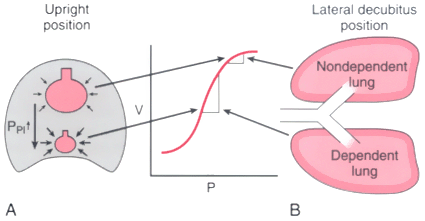 |
 |
Figure 49-10
Awake, closed-chest distribution of ventilation. A,
Pleural pressure (Ppl
) in an awake upright patient is most positive in
the dependent portion of the lung, and alveoli in this region are therefore most
compressed and have the least volume. Pleural pressure is least positive (most negative)
at the apex of the lung, and alveoli in this region are therefore least compressed
and have the largest volume. When these regional differences in alveolar volume
are translated to a regional transpulmonary pressure-alveolar volume curve, the small
dependent alveoli are on a steep (large-slope) portion of the curve, and the large
nondependent alveoli are on a flat (small-slope) portion of the curve. In this diagram,
regional slope equals regional compliance. Thus, for a given and equal change in
transpulmonary pressure, the dependent part of the lung receives a much larger share
of the tidal volume than the nondependent part of the lung does. B,
In the lateral decubitus position, gravity also causes pleural pressure gradients
and therefore similarly affects the distribution of ventilation. The dependent lung
lies on a relatively steep portion and the nondependent lung lies on a relatively
flat portion of the pressure-volume curve. Thus, in the lateral decubitus position,
the dependent lung receives most of the tidal ventilation. P, transpulmonary pressure;
V, alveolar volume. (From Benumof JL: Anesthesia for Thoracic Surgery.
Philadelphia, WB Saunders, 1987.)

 |
